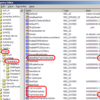PAgP facilitates the automatic creation of EtherChannel links by exchanging packets between channel-capable ports. The protocol learns the capabilities of port groups dynamically and informs the neighboring ports.
After PAgP identifies correctly paired channel-capable links, it groups the ports into a channel. The channel is then added to the spanning tree as a single bridge port. A given outbound broadcast or multicast packet is transmitted out one port in the channel only, not out every port in the channel. In addition, outbound broadcast and multicast packets transmitted on one port in a channel are blocked from returning on any other port of the channel.
There are four user-configurable channel modes: on, off, auto, and desirable. PAgP packets are exchanged only between ports in auto and desirable mode. Ports configured in on or off mode do not exchange PAgP packets. For switches to which you want to form an EtherChannel, it is best to have both switches set to desirable mode. This gives the most robust behavior if one side or the other encounters error situations or is reset. The default mode of the channel is auto. Both the auto and desirable modes allow ports to negotiate with connected ports to determine if they can form a channel. The determination is based on criteria such as port speed, trunking state, and native VLAN. Ports can form an EtherChannel when they are in different channel modes as long as the modes are compatible. This list provides examples:
- A port in desirable mode can successfully form an EtherChannel with another port
that is in desirable or auto mode.
- A port in auto mode can form an EtherChannel with another port in desirable
mode.- A port in auto mode cannot form an EtherChannel with another port that is also in
auto mode, since neither port initiates negotiation.- A port in on mode can form a channel only with a port in on mode because ports
in on mode do not exchange PAgP packets.- A port in off mode cannot form a channel with any port.
- Only the combination auto-desirable, desirable-desirable and on-on will allow a channel to be formed.
EtherChannel can be
- Ports in the channel can only be assigned to one VLAN
- Ethernet channels can be set up for fast Ethernet, Gigabit Ethernet, and 10 Gigabit
Ethernet.- Ethernet channels can indeed be set up as trunks.
- Ports within a Fast Ether Channel need to have identical duplex and speed
settings.- Port Aggregation Protocol (PAGP) facilitates the automatic creation of Fast Ether
channels links.
The PAgP modes are explained below.
- Off: PAgP will not run. The channel is forced to remain down.
- Auto: PAgP is running passively. The formation of a channel is desired; however, it is not initiated.
- Desirable: PAgP is running actively. The formation of a channel is desired and initiated.
- On: PAgP will not run. The channel is forced to come up.
Reference:
http://www.cisco.com/en/US/tech/tk389/tk213/technologies_tech_note09186a00800949c2.shtml#pagptoconfig



 The www.ipBalance.com runs by a volunteer group with IT professionals and experts at least over 25 years of experience developing and troubleshooting IT in general. ipBalance.com is a free online resource that offers IT tutorials, tools, product reviews, and other resources to help you and your need.
The www.ipBalance.com runs by a volunteer group with IT professionals and experts at least over 25 years of experience developing and troubleshooting IT in general. ipBalance.com is a free online resource that offers IT tutorials, tools, product reviews, and other resources to help you and your need.

![[Splunk] – Basic search fields and commands logo_splunk.png](https://ipbalance.com/wp-content/uploads/2009/06/logo_splunk-100x80.png)

